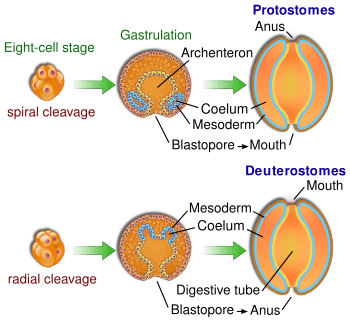Embryological origins of the mouth and anus

The embryological origin of the mouth and anus is an important characteristic, and forms the morphological basis for separating bilaterian animals into two natural groupings: the protostomes and deuterostomes.
In animals at least as complex as an earthworm, a dent forms in one side of the early, spheroidal embryo. This dent, the blastopore, deepens to become the archenteron, the first phase in the growth of the gut. In deuterostomes, the original dent becomes the anus, while the gut eventually tunnels through the embryo until it reaches the other side, forming an opening that becomes the mouth.[1] It was originally thought that the blastopore of the protostomes formed the mouth, and the anus was formed second when the gut tunneled through the embryo. More recent research has shown that our understanding of protostome mouth formation is somewhat less secure than we had thought. The edges of the dent appear to move together and close up in the middle, leaving openings at the ends that become the mouth and anus.[2] However, this idea has been challenged, because the Acoelomorpha, which form a sister group to the rest of the bilaterian animals, have a single mouth that leads into a blind gut (with no anus). The genes employed in the embryonic construction of the flatworm mouth are the same as those expressed for the protostomes, which suggests that the two structures are equivalent, and that the older ideas about protostome mouth formation were correct.[1] An alternative way to develop two openings from the blastopore during gastrulation, called amphistomy, appears to exist in some animals, such as nematodes.[3][4]
Humans, unlike the protostomes and other deuterostomes, already have a formed gut tube at the time of formation of the mouth and anus. In humans, the mouth is created first, during the fourth week of development, and the anus is created four weeks later.[5]
Evolutionary origin
| |||||||||||||||
Bilaterians evolved from a jellyfish-like ancestor, which was radially symmetrical. There have been suggestions that the blastopore started out as the digestive surface on a radial organism, which became elongated (and thus bilaterially symmetrical) before its sides closed over to leave a mouth at the front and an anus at the rear.[1] This matches with the "flaps-folding-over" model of gut formation, but an alternative view is that the original blastopore migrated forwards to one end of the ancestral organism, before deepening to become a blind gut.[1] This is consistent with living flatworms, which are basal to protostomes and deuterostomes. The story is a little more complex, because the blastopore itself does not go on to become the mouth.[1] However, flatworms, the sister group to the rest of the bilaterians, branched off from the ancestral stock before the bilaterian group originated, and have a mouth at one end and a blind gut.[1] This suggests that the last common ancestor of bilaterians had a similar gut configuration, and that the anus evolved after the mouth.[1]
Exactly how a through gut formed from this blind gut is somewhat harder to tell. The genetic mechanisms responsible for anus formation are quite variable, which might suggest that the anus evolved several times in different groups. Scientists are currently looking into this matter to generate a more complete picture.[1]
In humans, the development proceeds differently. The buccopharyngeal membrane is created in the foregut and it is perforated during the 4th week of human development, creating the primitive mouth, whereas the cloacal membrane is created in the hindgut and it is perforated during the 8th week of human development, creating the primitive anus after the mouth opening has already been created.[5]
Monophyly
The origin of the digestive tract separates the protostomes from the deuterostomes, and genetic data backs up the premise that the monophyletic[6] deuterostomes form a sister group to the monophyletic protostomes.[7][8] This confirmation is important because it paints a picture of the ancestral bilaterian having a blind gut, with two alternative methods of anus-development leading to the two groups of organisms that dominate the diversity of animal life today. In other words, the deuterostomes did not arise from within the protostomes by modifying the method of gut formation, but are an unrelated lineage; the significance of developing an anus is reflected by the success of these two clades.[7][8]
See also
References
- 1 2 3 4 5 6 7 8 Hejnol, A; Martindale, M.Q. (Nov 2008). "Acoel development indicates the independent evolution of the bilaterian mouth and anus.". Nature. 456 (7220): 382–6. doi:10.1038/nature07309. PMID 18806777.
- ↑ Arendt, D.; Technau, U.; Wittbrodt, J. (4 January 2001). "Evolution of the bilaterian larval foregut". Nature. 409 (6816): 81–85. doi:10.1038/35051075. PMID 11343117.
- ↑ Amphistomy - Contributions to Zoology
- ↑ Deuterostomic Development in the Protostome Priapulus caudatus
- 1 2 http://www.columbia.edu/itc/hs/medical/humandev/2004/Chapt18-Endoderm.pdf ENDODERMAL DERIVATIVES, FORMATION OF THE GUT AND ITS SUBSEQUENT ROTATION, Gershon, M. pages 18-3 - 18-13
- ↑ Lake, J.A. (1990). "Origin of the Metazoa". PNAS. 87 (2): 763–766. doi:10.1073/pnas.87.2.763. PMC 53346
 . PMID 2300560.
. PMID 2300560. - 1 2 Holland, L (2000). "Body-plan evolution in the Bilateria: early antero-posterior patterning and the deuterostome–protostome dichotomy". Current Opinion in Genetics & Development. 10 (4): 434. doi:10.1016/S0959-437X(00)00109-X.
- 1 2 Adoutte, A; Balavoine, G; Lartillot, N; De Rosa, R (1999). "Animal evolution: the end of the intermediate taxa?". Trends in Genetics. 15 (3): 104–8. doi:10.1016/S0168-9525(98)01671-0. PMID 10203807.